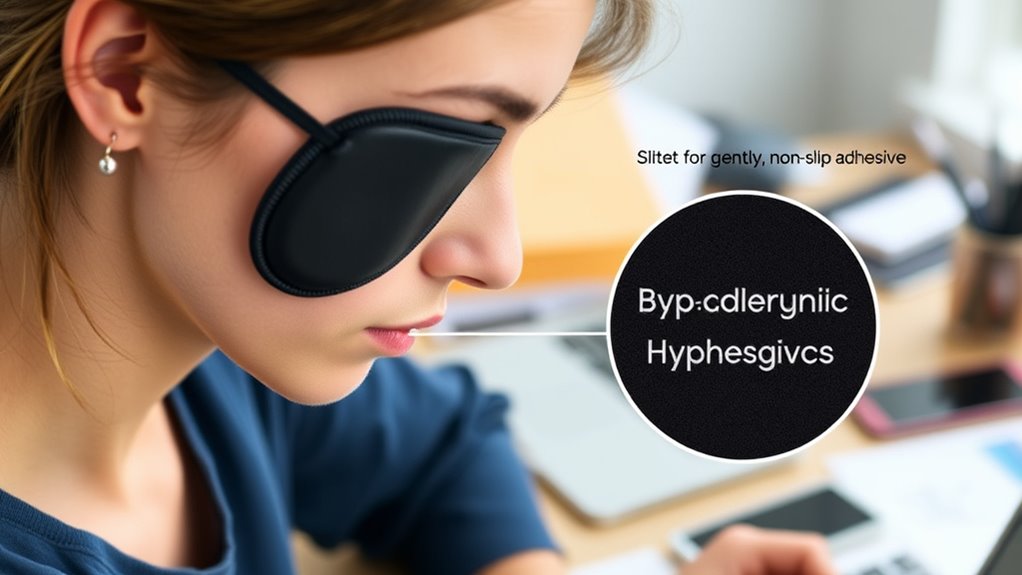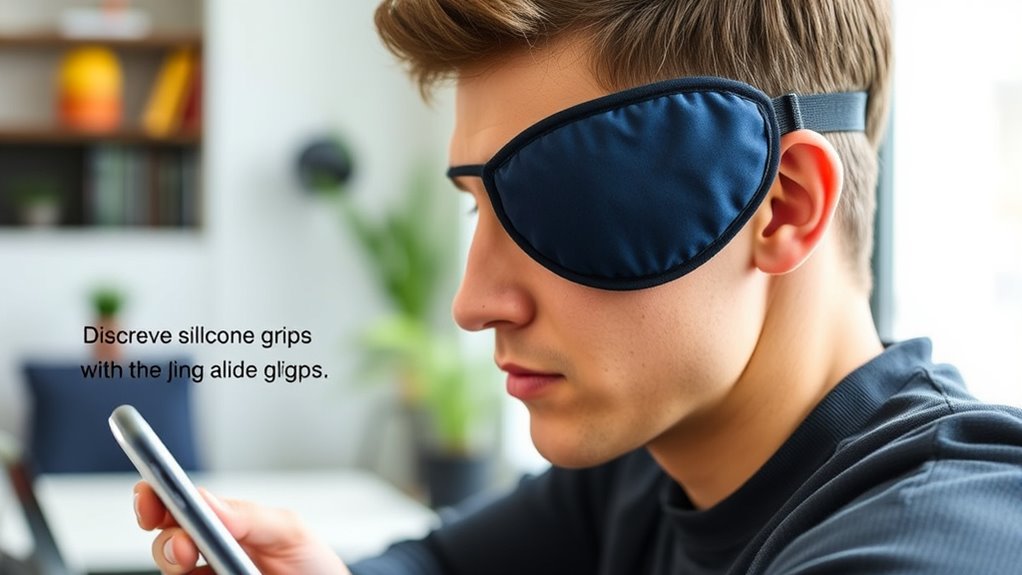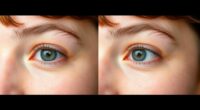To prevent slipping eye patches while multitasking, ensure you apply them on clean, dry skin using patches with strong, medical-grade adhesives. Trim facial hair around your eyes if possible, or use tape or adhesive boosters for better grip. Press firmly when attaching and avoid touching or adjusting the patch during activity. Choose patches designed to withstand moisture and sweat, and check them regularly throughout the day. Keep these tips in mind to keep your patch securely in place—there’s more to learn for ideal results.
Key Takeaways
- Use patches with strong, moisture-resistant adhesives and a contouring design for secure fit during multitasking.
- Prepare skin by cleaning and drying thoroughly, and consider applying medical tape around edges for extra hold.
- Manage facial hair by trimming or use skin-safe adhesive boosters to improve adhesion on uneven surfaces.
- Press the patch firmly for a few seconds after application and avoid touching or adjusting it during activities.
- Choose patches formulated for moisture and sweat resistance, and regularly check and replace as needed.

Wearing an eye patch can be essential for protecting your eye, but if it slips, it defeats the purpose. To keep it securely in place, you need to consider the adhesive strength of the patch and how facial hair might interfere with its grip. The adhesive plays a crucial role; if it’s weak or incompatible with your skin type, the patch will inevitably shift during daily activities. Look for eye patches with strong, medical-grade adhesives designed to stick for extended periods. Some patches come with a silicone or hydrocolloid backing that offers better adhesion without irritating your skin. Applying the patch on clean, dry skin also enhances its sticking power, so make sure to wash your face thoroughly before placement.
Secure your eye patch with strong, skin-friendly adhesive and prep clean, dry skin for optimal grip.
Facial hair can be a significant obstacle to maintaining a secure fit. If you have a beard, mustache, or sideburns, the patch may not adhere properly along the edges or might lift prematurely. In such cases, trimming the facial hair around the eye area can make a noticeable difference. Even a small trim can provide a flat surface for the adhesive to grip onto, minimizing the chances of slipping. For those who prefer not to trim, you can try using a skin-safe adhesive booster or a medical tape that helps secure the patch over facial hair. Applying the patch with a bit of gentle pressure for a few seconds after placement can also improve adhesion, especially along uneven surfaces caused by facial hair.
Another tip is to choose patches with a built-in adhesive border or a design that contours well to your face. Flexible, skin-matching materials tend to stay put better during movement or multitasking. When you’re active, avoid touching or adjusting the patch unnecessarily, as this can weaken the adhesive. If you notice the patch starting to loosen, reapply it with fresh adhesive or consider using a thin layer of medical-grade tape around the edges for added security.
Additionally, selecting patches that utilize adhesive technology designed for various skin types and conditions can significantly enhance their staying power. Finally, consider the environment — humidity, sweat, and oil can all reduce adhesive strength. If you’re going to be active or in a humid setting, opt for patches formulated to withstand moisture. Regularly inspect your patch throughout the day and replace it if it starts to lift or peel. Proper application, attention to facial hair, and choosing the right adhesive will help you keep your eye patch secure so you can go about your day without worry.
Frequently Asked Questions
Can Specific Fabrics Cause Eye Patches to Slip More?
Certain fabrics can cause eye patches to slip more because of fabric compatibility issues. Smooth, slick materials like silk or satin tend to reduce grip, making patches more likely to slide. Conversely, rougher fabrics like cotton or fleece provide better traction. When choosing patch material, consider how it interacts with your skin and the fabric compatibility, ensuring a secure fit so you can multitask comfortably without constant readjustments.
Are There Special Adhesives Suitable for Sensitive Skin?
If you’re concerned about slipping eye patches on sensitive skin, look for hypoallergenic adhesives and skin-friendly tapes. These products are designed to reduce irritation and provide a gentle yet secure hold. Always choose adhesives labeled for sensitive skin, and do a patch test before prolonged use. Proper application guarantees your eye patch stays in place, allowing you to multitask comfortably without worry about discomfort or slipping.
How Does Sweating Affect Eye Patch Adhesion?
Sweating causes moisture impact that can lead to adhesion challenges with your eye patch. When you sweat, the moisture reduces the adhesive’s grip, making it easier for the patch to slip or fall off. To keep it secure, dry your skin thoroughly before applying the patch, and consider using a sweat-resistant adhesive. Staying cool and avoiding excessive sweating during activities can also help maintain proper adhesion.
Can Skincare Products Interfere With Eye Patch Sticking?
Skincare products can definitely interfere with eye patch maintenance because oils, lotions, or creams create a barrier that weakens the adhesive. To keep your eye patch sticking, avoid applying skincare near your eyes before patching. If adhesive alternatives are needed, try using medical tape or silicone patches designed for sensitive skin. These options help guarantee your eye patch stays put, especially when you’re multitasking.
Is It Safe to Use Extra Adhesive for Better Grip?
Imagine needing to wear an eye patch during a busy day, and you wonder if using extra adhesive is safe. While increasing adhesive strength might seem helpful, it can affect skin compatibility, causing irritation or damage. It’s best to stick with medical-grade adhesives designed for skin, which balance grip and safety. Always test a small area first, and consult your healthcare provider if unsure, to prevent harm and ensure effective adhesion.
Conclusion
By following these tips, you’ll keep your eye patch secure and avoid unnecessary frustration. Remember, a little extra effort now can save you from constant readjustments later. Don’t let slipping patches throw you off your game—stay proactive and patient. Sometimes, it’s the small steps that make a big difference, proving that persistence pays off. Keep these tricks in mind, and you’ll master your eye patch with confidence, proving that a steady hand truly wins the race.










